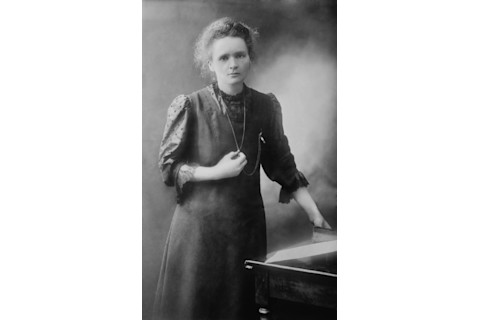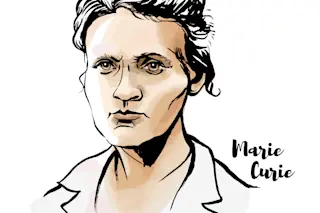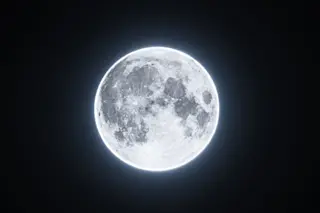Marie Curie (1867-1934) was a pioneering physicist and chemist who made groundbreaking contributions to science. She was often the only woman in a room full of male scientists. But that didn't stop her from being the first female to win a Nobel Prize, and the first and only to win the award in two separate fields.
Marie Curie’s Early Life as a Child Prodigy
The Polish-born French physicist gained recognition for her research on radioactivity, but she racked up accomplishments throughout her life. Marie was a child prodigy who exhibited extraordinary skills as young as age four. Born to two teachers who had instilled the value of education, 4-year-old Marie taught herself to read both French and Russian.
Equally as impressive was Marie's memory, which allowed her to recall vivid events from her toddler years.
Marie Curie's Education
In 1891, her French came in handy as the young scientist headed for Paris to further her education at Sorbonne University, where she studied chemistry, math and physics. There she discovered two radioactive elements: radium and polonium. Soon after, she met her husband and science partner, Pierre Curie.
Marie Curie’s Legacy in Science and Medicine

(Credit: Everett Collection/Shutterstock)
Everett Collection/Shutterstock
The Curie's discoveries on the properties of radioactive elements had a lasting impact, particularly in the fields of diagnosis and radiation therapy in medicine. Pierre and Marie shared a love for science and research, which led to their ground-breaking discovery of radioactivity — the spontaneous emission of energetic particles or waves via unstable atomic nuclei. The term radioactivity was coined by Marie herself and garnered the world's attention.
Marie Curie's Nobel Discoveries
For their groundbreaking work, Marie Curie and her husband received the Nobel Prize in physics in 1903. Even though Marie became the first woman to receive a Nobel Prize, she didn't stop there.
In 1911, she became the sole recipient of the Nobel Prize for chemistry for her work on pure radium. Today, Marie Curie's discoveries on the properties of radioactive elements have paved the way for diagnosis and radiation therapy in medicine.
Read More: Marie Curie: Iconic Scientist, Nobel Prize Winner … War Hero?
5 Fun Facts About Marie Curie

(Credit: Wimbdi/Shutterstock)
Wimbdi/Shutterstock
Here are five fun facts about Marie Curie, a radiant woman who paved the way for women in science and whose family continued her legacy of excellence.
1. Marie Curie’s Discoveries: Humble Settings
When you think of a Nobel Prize-winning physicist, you can only imagine how legit their workspace must be. Marie Curie may have broken barriers in science, but her lab was far from glamorous.
When Marie and her husband sought to conduct a series of experiments that would prove the existence of the elements radium and polonium, they needed plenty of space — a traditional laboratory just didn't make the cut. Turns out Team Curie opted to work out of an old shed for much of their Nobel prize-winning research.
2. Marie Curie: A World War I Hero
Curie helped save thousands of soldiers by developing mobile radiology units that were delivered to the front lines for army doctors to use. The portable technology allowed them to X-ray the wounded soldiers and helped guide their surgeries.
Over a million soldiers benefited from the “Petites Curies," Marie's invention that came with a generator, a hospital bed, an X-ray and the ability to save a life.
3. Marie Curie’s Family: A Dynasty of Nobel Prize Winners
Winning Nobel Prizes was a family affair: The Curie family earned five total Nobel Prizes. Marie held the most, with two to her name, while her husband, Pierre, held one. In 1935, daughter Irène Joliot-Curie followed in her parents' footsteps and received a Nobel alongside her husband, Frederic Joliot, for their discovery of new radioactive isotopes.
Following the family tradition, the youngest Curie married a Nobel Peace Prize winner, Henry Richardson Labouisse, who received the award as the head of UNICEF in 1965.
4. Marie Curie and Albert Einstein’s Relationship: An Intellectual Bond
Who would think that Albert Einstein would be part of the fun facts about Marie Curie? In 1906, Pierre was killed in a tragic road accident. As a grieving widow, Marie faced the brutal sexism that accompanied her fame as a solo female scientist.
It was then that Einstein decided to send a glowing letter to Marie in hopes of uplifting her. The note not only described how Einstein was inspired by her drive and intellect, but also that she had his full support. Here's what the father of modern physics had to say about this remarkable woman: “Marie Curie is, of all celebrated beings, the only one whom fame has not corrupted."
5. Marie and Pierre Curie: A Science Love Story
Marie and Pierre Curie's partnership forged a bond in both marriage and scientific endeavor that challenged the norms of their time. Nothing says true love like a shared passion for science. Marie and Pierre were introduced by Marie's colleague shortly after she graduated from Sorbonne University.
The dynamic duo soon became partners in both life and research. In fact, it was Pierre who insisted his wife be equally recognized when awarded the Nobel Prize for their scientific discoveries. Though Marie was often undermined as a woman in a male-dominated field, Pierre backed her every step of the way.
Read More: Meet 10 Women in Science Who Changed the World
Marie Curie FAQ
Where Was Marie Curie Born?
Marie Curie was born in Warsaw, in what was then the Kingdom of Poland, part of the Russian Empire, on November 7, 1867.
Where Did Marie Curie Learn?
Marie Curie studied at the Sorbonne University in Paris, where she earned her higher degrees and conducted her Nobel Prize-winning research.
Why Did Marie Curie Become a Scientist?
Marie Curie became a scientist due to her profound curiosity and passion for learning, driven by her desire to understand the natural world. Her father, who was a teacher of mathematics and physics, also greatly influenced her.
What Did Marie Curie Do?
Marie Curie was a physicist and chemist who conducted pioneering research on radioactivity. She developed methods for the separation of radium from radioactive residues, allowing for its study and use in medicine.
What Was Marie Curie Famous For?
Marie Curie is famous for being the first woman to win a Nobel Prize and the only person to win Nobel Prizes in two different sciences (physics in 1903, and chemistry in 1911).
What Did Marie Curie Discover?
Marie Curie's most notable discoveries include the radioactive elements radium and polonium. She also developed the theory of radioactivity (a term she coined) and techniques for isolating radioactive isotopes.
When Did Marie Curie Discover Radium?
Marie Curie and her husband, Pierre Curie, discovered radium in 1898.
What Did Marie Curie Do for Atomic Theory?
Marie Curie's work on radioactivity was crucial in the development of atomic theory. She provided key evidence that atoms are not indivisible, as previously thought, by showing that radioactive elements decay into other elements.
What Barriers Did Marie Curie Face?
Marie Curie faced numerous barriers, including gender-based discrimination in the scientific community, financial difficulties, and health issues related to her radiation work. Despite these challenges, she persisted and made groundbreaking scientific contributions.
When Did Marie Curie Die?
Marie Curie died on July 4, 1934, at the Sancellemoz Sanatorium in Passy, in the Haute-Savoie region of France.
How Did Marie Curie Die?
Marie Curie died from aplastic anemia, believed to be caused by prolonged exposure to radiation during her research and during her service in World War I, when she developed mobile X-ray units.
This story is part of an ongoing series exploring famous scientists. Read more about the greatest scientists of all time:
This article was originally published on Nov. 29, 2021 and has since been updated with new information from the Discover staff.















